Extended Passive Safety In 2017 Mercedes-Benz E-Class
 |
By Henny Hemmes
Senior European Editor
THE AUTO CHANNEL
The technology that allows the 2017 Mercedes-Benz E-Class to drive
almost driverless has been already reviewed extensively.
• SEE: First Drive Semi-Autonomous 2017 Mercedes-Benz E-Class.html.
However, there is more besides the technology that actively improves safety
by keeping an eye on traffic around the car, or on its driver.
• SEE: New E-Class Gets Car-to-X Communication.
No less important for the passengers in the new E-Class (W213) are the measures with respect to passive safety.
At the Estoril race track near Lisbon, Portugal, Mercedes had set up a
complete temporary building to host invited media during the first drive
event and to highlight a number of safety innovations, including the
upgrades of the Pre-Safe protection system that the car manufacturer uses
to protect occupants in its previous models.
• SEE: 2016 Mercedes-Benz E-Class Packed With New Safety Systems.
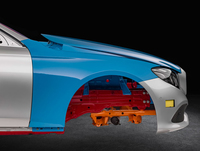 |
There was also an open structure to show the components of the safety systems of the new E-Class, as well as which parts are made of what material. Red is high strength steel, purple is ultra high strength steel (hot formed), blue is aluminum, while the engine cradle is yellow.
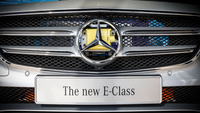 |
You could see the short-range radar sensors in the bumper, which for the first time enable the Pre-Safe system to use their information in order to tension the front seat belts during the last fraction of a second before an unavoidable accident. This contributes to reduction of forces on the driver and front passenger during the crash. The E-Class has nine airbags as standard, four seat belt tensioners and belt force limiters, as well as the so-called Neck-Pro head restraints for driver and front passenger, shifting forward and up during a crash.
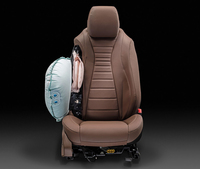 |
Push Away
Mercedes has equipped the car with new thorax-pelvis sidebags to reduce
the forces to the upper body and pelvis during a side collision. There is
also the new subsystem, called Pre-Safe Impulse Side that is part of the
Driving Assistance Plus package. It premiers the use of air chambers,
integrated in the side bolsters of the backrests of the front seats. As
soon as the system recognizes an inevitable side impact, a compact air
bladder in the outer bolster is inflated, pushing the occupant to the
center of the car, away from the door where the collision is imminent.
Ralf Bogenrieder, the responsible engineer, explains that the airbag is filled with gas from a canister that's mounted in the backrest: "Pushing away the body increases the distance between the door and the body, increasing the crumple zone from 1.2 inches to 2 inches. Tests showed that the relative velocity can be reduced between the occupant and the loads on the rib cage by 50 percent."
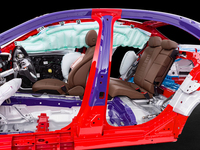 |
Improved Curtain Airbags
Side airbags for the rear passengers are an option, as well as automatic
and adaptive seat belt force limiters, which automatically adjust to the
size and weight of the passengers. The three-point belt bags are a mix of a
belt and an airbag. They are installed for all occupants on the front seats
and on the outer rear seats. They are recognizable by their thickness, but
hidden, of course, are the curtain airbags, which span the entire length of
the A-pillar to the C-pillar and which are of a thicker, stronger material.
To protect passengers during a rollover, they remain inflated for a longer
time than the other airbags, which implode within a faction of a second
after they have been activated.
Pre-Safe Sound Protects The Ears
Also new is Pre-Safe Sound, an innovation that Mercedes uses to prepare
the natural reflex of the ears of the occupants for the loud noise of a
collision. Nature has provided our ears with a muscle, the stapedius, which
is responsive to loud noises and contracts in a reflex, changing the
connection between the tympanic membrane and inner ear, resulting in a
better protection against high sound pressures. Mercedes uses the natural
reflex as a biomechanical ear protection and the system emits a short noise
through the car’s sound system if there is a risk of a collision. The
signal triggers the reflex of the stapedius and prepares the ears for the
noise to prevent or reduce hearing damage or discomfort.
Improved Side-Impact Protection
Near the open structure, safety engineer Matthias Stuck explains that in
the new E-Class less sensors could be used for Pre-Safe. He also points at
the red high strength steel parts that have been used to reinforce the
structure. We see that a reinforced aluminum rear end member is mounted in
the wheel wells for further protection of the fuel tank (blue).
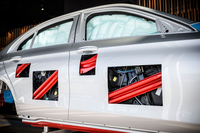 |
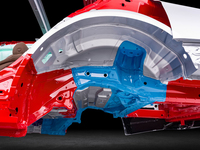 |
Softer Landing For Pedestrians
The measures for pedestrian protection include Active Brake Assist that
warns if pedestrians are detected and, if necessary, initiates autonomous
braking if the driver does not react. In addition, the E-Class has a newly
designed and energy-absorbing front end and an energy-absorbing bonnet,
called Active Hood. If necessary, the latter is supposedly engaged to
provide more space underneath the hood for deformation and/or energy
absorption when a pedestrian falls on it. In that case, it automatically
lifts the hood over 3 inches.
 |
With the new or added technology, in combination with the existing
safety systems, the 2017 E-Class has a more extensive safety equipment than
its predecessor and is the safest car on the road. Apart from that, it
looks good and offers comfortable and dynamic handling.
• SEE: First Drive Review - 2017 Mercedes-Benz E-Class.
As of now, the new ‘E’ has all the latest automotive safety technology. Needless to say, when the face-lifted S-Class arrives in 2017, it too will get all systems of the E-Class and more. Of course, when the new BMW 5-Series is introduced it may have some additional safety features that will undoubtedly spur Mercedes on to new innovations.


